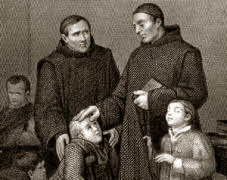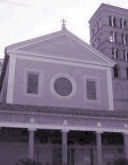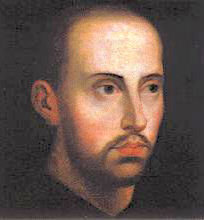Lent: March 8th
Tuesday of the First Week of Lent; Optional Memorial of St. John of God, religious
» Enjoy our Liturgical Seasons series of e-books!
First Reading (excerpt), Is 55:10-11:
For as the rain and the snow come down from heaven, and return not thither but water the earth, making it bring forth and sprout, giving seed to the sower and bread to the eater, so shall my word be that goes forth from my mouth; it shall not return to me empty, but it shall accomplish that which I purpose, and prosper in the thing for which I sent it.
Today's Mass shows the Church's constant effort to acquaint us with the teaching of her Founder, and to strengthen us to follow and live his teachings. Mere formalism and externalism are of no value in the religion of Christ. God demands of his people a worship in spirit and in truth, and a conversion which comes from the heart.
Lent is a good time to seek the Lord. It is a special time of divine mercy and grace. The Church, acting as God's prophet, calls us to return to the Lord by true penance. The word of God which is sown so abundantly during Lent should grow and bear fruit in us if we have really prepared ourselves by fasting and discipline of the flesh. —St. Andrew Bible Missal
"God is love! Whoever abides in love; abides in God and God in him" (motto of St. John's community). St. John of God, who was of Portuguese descent, was first a shepherd, a dealer and then a soldier. At the age of forty he was converted, and devoted himself to the care of those sick in mind, showing himself in this thankless task to be a true innovator and a saint of super-human heroism. He founded the Order of the Brothers Hospitallers, which bears his name. He died at Granada in 1550. Pope Leo XIII declared him Patron of Hospitals and Patron of the Sick and commanded his name to be placed in the Litanies of the Dying.
Meditation—Tuesday of the First Week of Lent:
In the liturgical texts for today is hidden the mystery of the Mother of God, intimately connected with that of the incarnation of the Son of God. Let us look at the texts, and begin with the reading from the prophet Isaiah.
So shall my word be that goes forth from my mouth: it shall not return to me empty (55, 11)
When the prophet Isaiah made this affirmation, it was not at all to bring out something merely trivial, but rather a contradiction of what might be expected. For this passage belongs certainly to the story of the passion of Israel, where we read that God’s appeals to his people were continually defeated and that his word invariably remained fruitless, while God appears seated astride history, but not as a conqueror. For everything happened as a sign: the crossing of the Red Sea, the blossoming of the period of the Kings, the return of Israel to their country out of exile, all this now fades away. God’s seed in the world seems to give no results. The prophecy, therefore, however wrapped in obscurity, is an encouragement to all those who, in spite of everything continue to believe in the power of God, convince that the world is not just rocky soil in which the seed cannot find room to grow, but certain that the soil will not always be only a thin layer on the surface from which the birds day by day peck out suddenly what seed has there fallen upon it. (cf. Mk 4,1-9).
For us Christians an affirmation of this kind has the ring of the promised coming of Jesus Christ, thanks to which the word of God has now truly penetrated into the earth and has become bread for us all: seed which bears fruit through the ages, a fruitful response in which God’s discourse has taken root in this world in vital fashion. It is difficult to find elsewhere the mystery of Christ allied to that of Mary in a form as clear and condensed as in the perspective of this promise: for when it affirms that the word, or better the seed, bears fruit, it means to say that it does not fall on the ground to rebound like a ball, but that instead it penetrates deeply into the soil to absorb the moisture there and transform it into itself, truly producing something new, transubstantiating that same earth into fruit. The grain does not remain alone: this is part of the fertility mystery of the earth—Mary, the holy soil of the Church, as the Fathers fittingly call her, belongs to Christ. The mystery of Mary signifies in this connection that the word does not remain alone; rather it assumes the other, the earth, into itself; in the earth of the Mother the word becomes man, and now, mingled with the soil of the whole of humanity, it can return again to God.
The Gospel on the other hand seems to be speaking of something quite different. Here it is a question of our mode of prayer, its correct form, its proper content, the way to comport ourselves, and genuine recollection: not so much therefore of what it is for God to do, but of how we ought to act before him. In reality the two readings are interdependent; we might say that in the Gospel we come now to see how it is possible for human beings to become a fertile field for the word of God. This they can become by preparing those elements by which a life can grow and mature. They attain this end by themselves living from these elements, thus transforming themselves, being impregnated with the word, in the word, immersing their life in prayer and therefore in God.
So this Gospel, then, accords with the introduction to the Marian mystery given by Luke, when in more than one place he says of Mary that she ‘kept’ the word in her heart (2,19; 2,51). Mary united in herself the various currents in Israel; in her prayer she bore within herself the suffering and the greatness of that history, to convert it into a fertile land for the living God. To pray undoubtedly means much more, as the Gospel tells us, than speaking without reflection, merely mouthing words. To be a field for the word means to be earth which allows itself to be absorbed by the seed, which assimilates itself to the see, renouncing itself so as to make the seed germinate. With her motherhood Mary transfused into it her very substance, body and soul, so that a new life might come forth. The saying about the sword which would pierce her soul (Lk 2,35) has a much greater and more profound meaning: Mary makes herself completely available as the soil, she allows herself to be used and consumed so as to be transformed into him, who has need of us in order to become the fruit of the earth.
In the Collect for today we are called upon to have a longing desire for God. The Fathers of the Church maintain that to pray is nothing else than to turn into a longing desire for the Lord. In Mary this petition is heard: she is, may I say, a vessel of desire in whom life becomes prayer, and prayer life. St. John has wonderfully alluded to such a process of transformation while not calling Mary by name in his Gospel. He refers to her solely as the mother of Jesus. She in a certain sense set aside whatever in her life was personal, so as to be uniquely at the disposal of the Son; and it is precisely in this that Mary realised her personality.
I think that such links between the mystery of Christ and that of Mary put before us by today’s Readings are of great importance for the Western activistic mentality, which has reached its peak in our age. For to our way of thinking the principle of domination alone still has value.: action, production, planning the world and, along with that, reconstructing it by ourselves, without owing anything to anybody but confidently relying on our own resources. With such a mentality, then, it is not by chance that we have more and more separated Christ from his mother, without taking account of how Mary as his mother, could signify something indispensable for theology and for faith. The whole of this way of considering the Church thus starts out from an erroneous way of thinking. We may even ourselves consider it as a technical product which we intend to programme cleverly and bring to realization with a tremendous expenditure of energy. We wonder whether that can happen which St. Louis-Marie Grignon de Montfort appended to a passage from the prophet Haggai “You have done much but nothing has come of it” (1,6). “If doing takes the upper hand, becoming autonomous, then those things which are not manufactured, but are living and need to mature, will no longer be able to exist.”
We want to get out of this one-sided outlook belonging to Western activism in order not to degrade the Church to a product of our doing and planning. The Church is not a finished artefact but always living from God, needing to develop and achieve maturity. For this she requires the Marian mystery, just as she herself is the mystery of Mary. She can train herself to that fecundity only if she submits to that sign; only then does she become holy soil for the word. We should adopt the symbol of the fertile soil, we should become people who hope, harvesting their own inner lives, persons who, deep within their prayer, their longing and their faith, make room for growth.
—Cardinal Joseph Ratzinger (Pope Benedict XVI), Journey Towards Easter
St. John of God
In 1503, at the age of eight, John fled from his parents for some unknown reason. For a while he was a shepherd, then a book dealer. Matters spiritual were of no particular interest until he heard the preaching of Blessed John of Avila. Then his conversion was so sincere and sudden that he was considered to be out of his mind. He was incarcerated in the Royal Hospital in Granada, and suffered the cruel treatment of the day. Here he discovered how to show his love for God, through caring for those who were unable to respond to this cruel treatment. He resolved to devote the remainder of his life caring for people living on the margins of society.
Following John’s death on his 55th birthday, March 8th, his helpers banded together to live in the same radical, spiritual way of Hospitality that John had exemplified and in 1572 they were approved by Pius V, as the Hospitaller Brothers of (St) John of God. The members bind themselves by a fourth vow, the service of the sick. Because of his work our saint has become the patron of hospitals and the dying. His name is in the Litany of the Dying.
—From St. John's Life by Bihlmeyer
 On July 3, 1549, a fire broke out in the kitchen of the Royal hospital at Granada that had been founded by the Spanish king and queen, Ferdinand and Isabella. It threatened to spread to the large wards where hundreds of sick were lying. The storm and fire bells rang loudly. People rushed from all sides, John in the lead. The fire was beyond control, firemen and volunteers were unable to extinguish it. No one dared to enter the burning building from which came the pitiful cries of the sick in the agony of imminent and certain death. Fire and smoke choked the exits. Those who could still arise from their beds stood pleading at the windows. The scene was enough to drive a person insane.
On July 3, 1549, a fire broke out in the kitchen of the Royal hospital at Granada that had been founded by the Spanish king and queen, Ferdinand and Isabella. It threatened to spread to the large wards where hundreds of sick were lying. The storm and fire bells rang loudly. People rushed from all sides, John in the lead. The fire was beyond control, firemen and volunteers were unable to extinguish it. No one dared to enter the burning building from which came the pitiful cries of the sick in the agony of imminent and certain death. Fire and smoke choked the exits. Those who could still arise from their beds stood pleading at the windows. The scene was enough to drive a person insane.
John could not stand idly by. Disregarding smoke and flame, he rushed in among the sick, opened doors and windows, gave terse orders and directions as to how they who could might save themselves; some he led, others he dragged or carried into the open, often two at a time. When all the bedridden were safe, he wasted no time in throwing coverlets, bed clothing, chairs and other valuables out of the windows, thus saving the property of the poor.
Then he took an axe, climbed to the roof and began chopping away vigorously. Suddenly the liberated flames leapt up high beside him. He fled, only to continue his heroic work in another part of the building. There too a wave of fire soon stopped him. He was standing literally between two infernos. Moments passed, he was lost in the heat of the flames and the choking smoke. A quarter of an hour—loud cries of fear could be heard for the brave man—and then he sprang from the fire, blackened by smoke but unscathed except for singed eyebrows. Joyously the crowd surrounded him, congratulating the savior of the sick. John's modesty, however, prevented him from accepting praise and honors.
—Excerpted from The Church's Year of Grace, Pius Parsch
Patronage: against alcoholism; against bodily ills; against sickness; alcoholics; bookbinders; booksellers; dying people; firefighters; heart patients; hospitals (proclaimed on 22 June 1886 by Pope Leo XIII); hospital workers; nurses (proclaimed in 1930 by Pope Pius XI); publishers; printers; sick people; Tultepec, Mexico; Montemor-o-Novo, Portugal
Symbols and Representation: The pomegranate—the fruit which represents charity and love, in the Bible, is the coat of arms of the Hospitaller Order and its motto is “God is Love”. John is depicted in art washing the feet of Jesus. A famous painting by Gomez-Moreno 1880 depicts John rescuing the patients from the inferno at the Royal Hospital (where he himself had been a patient 10 years earlier) where not even one life was lost. Also: alms; alms box around his neck; cord; crown of thorns; heart; rope
Highlights and Things to Do:
- Read more about St. John of God:
- Find out more about the Order of Hospitality of St. John of God.
- St. John of God remains are in a silver urn within the gilded Baroque altarpiece above the main altar in the Basílica de San Juan de Dios or Basilica of St. John of God in Granada, Spain.
- See the statue of St. John of God in St. Peter's Basilica.
- St. John of God followed his impulses when it came to serving Christ. He never reconsidered or second-guessed the inspirations of the Holy Spirit, but he acted on them instantly, whether or not they seemed practical. Today do not dissuade yourself from doing heroic little acts of charity, but follow God's will immediately as it is manifested to you.
- St. John of God never thought of himself but always reached out to others. Examine your conscience tonight and ask yourself: do I habitually give greater importance to others' needs before my own? Do I esteem myself over-highly, or do I consider myself of least importance?
- It is often overlooked in present-day hospital methods that characterized the age-old practice of the Church, viz., a harmonious, organic relationship between liturgy and care of the sick. Pray the Litany of the Sick for those hospitalized. And pray that hospital care will incorporate the Christian dimension and respect each person as an image of God.

Friday of the Third Week of Lent
Station with San Lorenzo in Lucina (St. Lawrence in Lucina):
The original church dedicated to the popular deacon martyr St. Lawrence was erected in the 4th century on the ruins of a house belonging to the Roman lady Lucina. Near the church was a well which was very dear to the Romans and which probably suggested the Epistle and Gospel of today's Mass. The church also contains a part of the gridiron on which St. Laurence was burned. The Introit and Gradual from the previous Missal (1962) refer to the prayers of the Saint while he was being tortured.
For more on San Lorenzo in Lucina, see:
For further information on the Station Churches, see The Stational Church.








